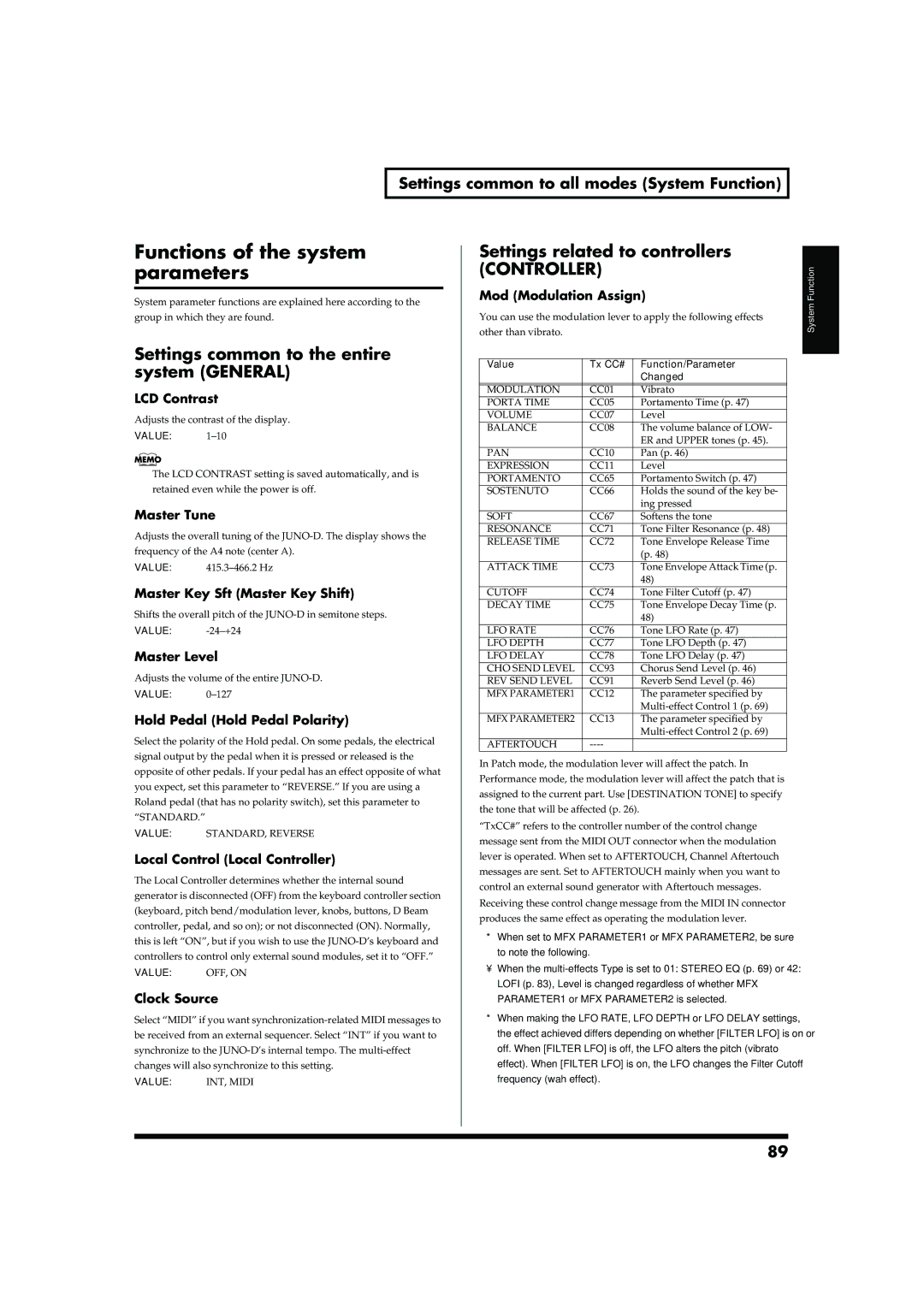
Settings common to all modes (System Function)
Functions of the system parameters
System parameter functions are explained here according to the group in which they are found.
Settings common to the entire system (GENERAL)
LCD Contrast
Adjusts the contrast of the display.
VALUE:
The LCD CONTRAST setting is saved automatically, and is retained even while the power is off.
Master Tune
Adjusts the overall tuning of the
VALUE: |
Master Key Sft (Master Key Shift)
Shifts the overall pitch of the
VALUE:
Master Level
Adjusts the volume of the entire
VALUE:
Hold Pedal (Hold Pedal Polarity)
Select the polarity of the Hold pedal. On some pedals, the electrical signal output by the pedal when it is pressed or released is the opposite of other pedals. If your pedal has an effect opposite of what you expect, set this parameter to “REVERSE.” If you are using a Roland pedal (that has no polarity switch), set this parameter to “STANDARD.”
VALUE: STANDARD, REVERSE
Local Control (Local Controller)
The Local Controller determines whether the internal sound generator is disconnected (OFF) from the keyboard controller section (keyboard, pitch bend/modulation lever, knobs, buttons, D Beam controller, pedal, and so on); or not disconnected (ON). Normally, this is left “ON”, but if you wish to use the
VALUE: OFF, ON
Clock Source
Select “MIDI” if you want
VALUE: | INT, MIDI |
Settings related to controllers
(CONTROLLER)
Mod (Modulation Assign)
You can use the modulation lever to apply the following effects
other than vibrato.
Value | Tx CC# | Function/Parameter |
|
| Changed |
|
|
|
MODULATION | CC01 | Vibrato |
PORTA TIME | CC05 | Portamento Time (p. 47) |
VOLUME | CC07 | Level |
BALANCE | CC08 | The volume balance of LOW- |
|
| ER and UPPER tones (p. 45). |
PAN | CC10 | Pan (p. 46) |
EXPRESSION | CC11 | Level |
PORTAMENTO | CC65 | Portamento Switch (p. 47) |
SOSTENUTO | CC66 | Holds the sound of the key be- |
|
| ing pressed |
SOFT | CC67 | Softens the tone |
RESONANCE | CC71 | Tone Filter Resonance (p. 48) |
RELEASE TIME | CC72 | Tone Envelope Release Time |
|
| (p. 48) |
ATTACK TIME | CC73 | Tone Envelope Attack Time (p. |
|
| 48) |
CUTOFF | CC74 | Tone Filter Cutoff (p. 47) |
DECAY TIME | CC75 | Tone Envelope Decay Time (p. |
|
| 48) |
LFO RATE | CC76 | Tone LFO Rate (p. 47) |
LFO DEPTH | CC77 | Tone LFO Depth (p. 47) |
LFO DELAY | CC78 | Tone LFO Delay (p. 47) |
CHO SEND LEVEL | CC93 | Chorus Send Level (p. 46) |
REV SEND LEVEL | CC91 | Reverb Send Level (p. 46) |
MFX PARAMETER1 | CC12 | The parameter specified by |
|
| |
MFX PARAMETER2 | CC13 | The parameter specified by |
|
| |
AFTERTOUCH |
|
In Patch mode, the modulation lever will affect the patch. In Performance mode, the modulation lever will affect the patch that is assigned to the current part. Use [DESTINATION TONE] to specify the tone that will be affected (p. 26).
“TxCC#” refers to the controller number of the control change message sent from the MIDI OUT connector when the modulation lever is operated. When set to AFTERTOUCH, Channel Aftertouch messages are sent. Set to AFTERTOUCH mainly when you want to control an external sound generator with Aftertouch messages. Receiving these control change message from the MIDI IN connector produces the same effect as operating the modulation lever.
*When set to MFX PARAMETER1 or MFX PARAMETER2, be sure to note the following.
•When the
*When making the LFO RATE, LFO DEPTH or LFO DELAY settings, the effect achieved differs depending on whether [FILTER LFO] is on or off. When [FILTER LFO] is off, the LFO alters the pitch (vibrato effect). When [FILTER LFO] is on, the LFO changes the Filter Cutoff frequency (wah effect).
System Function
89
